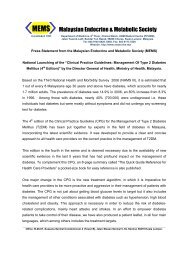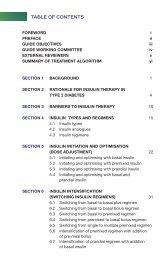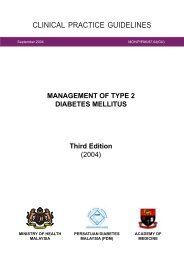JAFES-Booklet (English - pdf - 1103 Kb) - MEMS
JAFES-Booklet (English - pdf - 1103 Kb) - MEMS
JAFES-Booklet (English - pdf - 1103 Kb) - MEMS
You also want an ePaper? Increase the reach of your titles
YUMPU automatically turns print PDFs into web optimized ePapers that Google loves.
Bilateral Adrenal Hyperplasia In<br />
Multiple Endocrine Neoplasia Type 2A<br />
Gunasekaran R, Zanariah H<br />
Endocrinology Unit, Department of Medicine, Hospital Putrajaya<br />
Multiple Endocrine Neoplasia (MEN) 2A is an autosomal dominant disease, characterized by the<br />
development of Medullary Thyroid Carcinoma, Pheochromocytoma and hyperparathyroidism.<br />
Genetic studies have identified the presence of germline mutations in the RET proto-oncogene in<br />
almost 100 percent of MEN 2 patients.<br />
In MEN 2A, pheochromocytoma occurs in 40 to 50 percent of patients, usually arising in the adrenal<br />
glands and rarely occurs at extra-adrenal sites. In contrast to sporadic pheochromocytoma,<br />
the adrenal involvement within MEN 2A begins with adrenal medullary hyperplasia and is multicentric<br />
and bilateral in more than 50 percent of cases. Pheochromocytomas are almost always<br />
benign, but some tend to recur locally. These tumors usually produce adrenaline disproportionately<br />
to noradrenaline, in contrast to sporadic cases. Hypertension in MEN 2A patients with pheochromocytoma<br />
is more often paroxysmal than sustained, in contrast to the usual sporadic case.<br />
MEN 2A patients with pheochromocytomas may have paroxysmal palpitations, anxiety, headaches,<br />
or sweating but many remain asymptomatic.<br />
We describe a 52-year-old man who was referred to us for further evaluation and follow-up of his<br />
elevated urinary catecholamines and adrenal abnormalities on the CT scan.<br />
He was initially diagnosed to have medullary thyroid carcinoma with regional lymph node metastases.<br />
He underwent total thyroidectomy and neck dissection 9 years back and is currently on<br />
thyroxine replacement with persistent mild elevation of serum calcitonin levels in the absence of<br />
clinically discernible disease. Serum calcium levels have remained within normal range. Genetic<br />
testing had detected a mutation on codon 634. Regular screening of urinary catecholamines<br />
revealed progressive elevation above normal and most recently, urinary adrenaline levels were<br />
elevated five-fold without significant elevation of noradrenaline. Serial CT scan of the adrenals<br />
showed gradual progressive nodularity of both adrenals in keeping with probable adrenal medullary<br />
hyperplasia. An additional extra-adrenal lesion was identified adjacent to the left adrenal<br />
gland. Further investigation with I-131-metaiodobenzylguanidine (MIBG) scintigraphy is planned<br />
prior to considering the timing and extent of surgical approach for the adrenal disease.<br />
26













